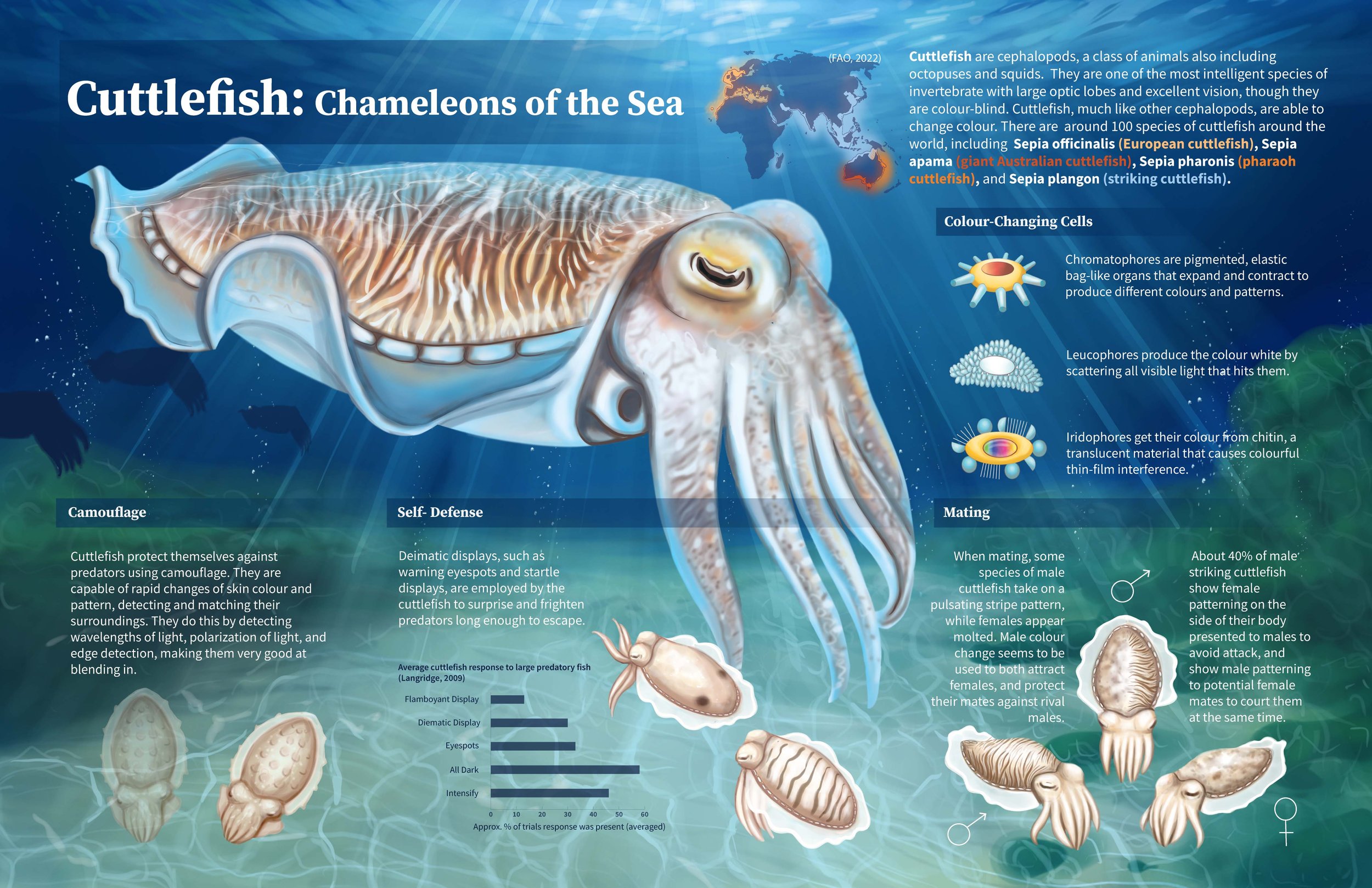Cuttlefish: Chameleons of the Sea
Infographic
Scientific Illustration, Infographic, Data Visualization
Description
This work is designed to be a poster or museum plaque geared towards laymen.
The focus is on explaining the mechanisms of cuttlefish colour change, as well as describing some of the behavioral reasons for colour change in several cuttlefish species.
Year
2022
Tools
Adobe Photoshop, Adobe Illustrator
Media
Print- academic poster or museum plaque
Client
Jodie Jenkinson
Audience
General public/ Lay audience
Process
First, I compiled salient information from research and extracted key concepts. I organized information into categories (e.g. colour changing cells, camouflage mechanisms, mating behaviour, etc.). I used colour coding to keep track of what source information was from.
BRAINSTORM
Next, I completed a first draft. I started by rendering the background to get an idea of how to integrate visual elements.
FIRST DRAFT
I then replaced all placeholder boxes with sketches and graphics. I additionally added copy at this stage. Each element was created individually in Adobe Photoshop through digital painting then linked to Adobe Illustrator, where assets were arranged. Graphs were created using Adobe Illustrator.
SECOND DRAFT
Lastly, each digitally painted asset was fully rendered using Adobe Photoshop, and elements were adjusted to finalize the composition.
FINAL IMAGE
Details
References
Brown, C., Garwood, M. P., & Williamson, J. E. (2012). It pays to cheat: Tactical deception in a cephalopod social signalling system. The Royal Society: Biology Letters, 8(5), 729-732. https://www.ncbi.nlm.nih.gov/pmc/articles/PMC3440998/
Carere, C., Grignani, G., Bonanni, R., Gala, M. D., Carlini, A., Angeletti, D., Cimmaruta, R., Nascetti, G., & Mather, J. A. (2015). Consistent individual differences in the behavioral responsiveness of adult male cuttlefish (Sepia officinalis). Applied Animal Behaviour Science, 165, 89-95. https://www.sciencedirect.com/science/article/pii/S016815911500091X
Darmaillacq, A. S., & Osorio, D. (2017). Cuttlefish. Cell: Current Biology, 27(20), PR1093-R1095. https://www.cell.com/current-biology/fulltext/S0960-9822(17)31110-7
Deravi, L. F., Magyar, A. P., Sheehy, S. P., Bell, G. R. R., Mäthger, L. M., Senft, S. L., Wardill, T. J., Lane, W. S., Kuzirian, A. M., Hanlon, R. T., Hu, E. L., Parker, K. K. (2014). The structure-function relationships of a natural nanoscale photonic device in cuttlefish chromatophores. The Royal Society. https://royalsocietypublishing.org/doi/10.1098/rsif.2013.0942
Food and Agriculture Organization of the United Nations: Fisheries and Aquaculture Department. (2022). Aquatic species distribution map viewer. https://www.fao.org/figis/geoserver/factsheets/species.html?species=GRC-m&prj=4326#speciesSelectorPanel
Gilmore, R., Crook, R., & Krans, J. L. (2016). Cephalopod camouflage: Cells and organs of the skin. Nature education, 9(2), 1. https://www.nature.com/scitable/topicpage/cephalopod-camouflage-cells-and-organs-of-the-144048968/
Hanlon, R. T., Mäthger, L. M., Bell, G. R. R., Kuzirian, A. M., & Senft, S. L. (2018). White reflection from cuttlefish skin leucophores. Bioinspiration & Biomimetics, 13(3). https://iopscience.iop.org/article/10.1088/1748-3190/aaa3a9/pdf
Kelman, E. J., Baddeley, R. J., Shohet, A. J., & Osorio, D. (2007). Perception of visual texture and the expression of disruptive camouflage by the cuttlefish, Sepia officinalis. The Royal Society. https://royalsocietypublishing.org/doi/10.1098/rspb.2007.0240
Langas, G. (n.d.). A Coral on a Clear Ocean Floor [Photograph]. Pexels. https://www.pexels.com/photo/a-coral-on-a-clear-ocean-floor-8589519/
Langridge, K. V. (2009). Cuttlefish use startle displays, but not against large predators. Animal Behaviour, 77(4), 847-856. https://reader.elsevier.com/reader/sd/pii/S0003347208005721?token=443E95278408A3927EF476E5D53595B30C94FB8DB84D08FC2C6E13C0CA0FAC5868185FAA87C77E7C9B730747E5DF561D&originRegion=us-east-1&originCreation=20220210052244
Mäthger, L. M., Chiao, C., Barbosa, A., & Hanlon, R. T. (2008). Colour matching on natural substrates in cuttlefish, Sepia officinalis. J Comp Physiol A Neuroethol Sens Neural Behav Physiol, 194(6), 577-585. https://pubmed.ncbi.nlm.nih.gov/18414874/
Nabhitabhata, J., & Nilaphat, P. (1999). Life cycle of cultured pharaoh cuttlefish, Sepia Pharaonis Ehrenberg, 1831. Phuket Marine Biological Center, 19(1), 25-40. https://www.researchgate.net/publication/230788644_Life_Cycle_of_Cultured_Pharaoh_Cuttlefish_Sepia_pharaonis_Ehrenberg_1831#:~:text=The%20average%20life%20span%20was,strategy%20as%20short%20generation%20mode
Normal, M., & Reid, A. (2000). A guide to squid, cuttlefish and octopuses of Australasia. Mark Normal and Amanda Reid.
Norman, M. D., Finn, J., & Tregenza, T. (1999). Female impersonation as an alternative reproductive strategy in giant cuttlefish. The Royal Society. https://royalsocietypublishing.org/doi/pdf/10.1098/rspb.1999.0786
Otaka, R. (2019, June 14). Capture the iridescence of camouflaging cephalopod skin. Science Friday. https://www.sciencefriday.com/educational-resources/capture-the-iridescence-of-camouflaging-cephalopod-skin/
Reiter, S., Hülsdunk, P., Woo, T., Lauterbach, M. A., Eberle, J. S., Akay, L.A., Longo, A., Meier-Credo, J., Kretschmer, F., Langer, J. D., Kaschube, M., & Laurent, G. Elucidating the control and development of skin patterning in cuttlefish. Nature 562, 361-366. https://www.nature.com/articles/s41586-018-0591-3
Vardion, & Pluribus, A. (n.d.). BlankMap-World-noborders [Digital image]. Wikimedia Commons. https://commons.wikimedia.org/wiki/File:BlankMap-World-noborders.png







